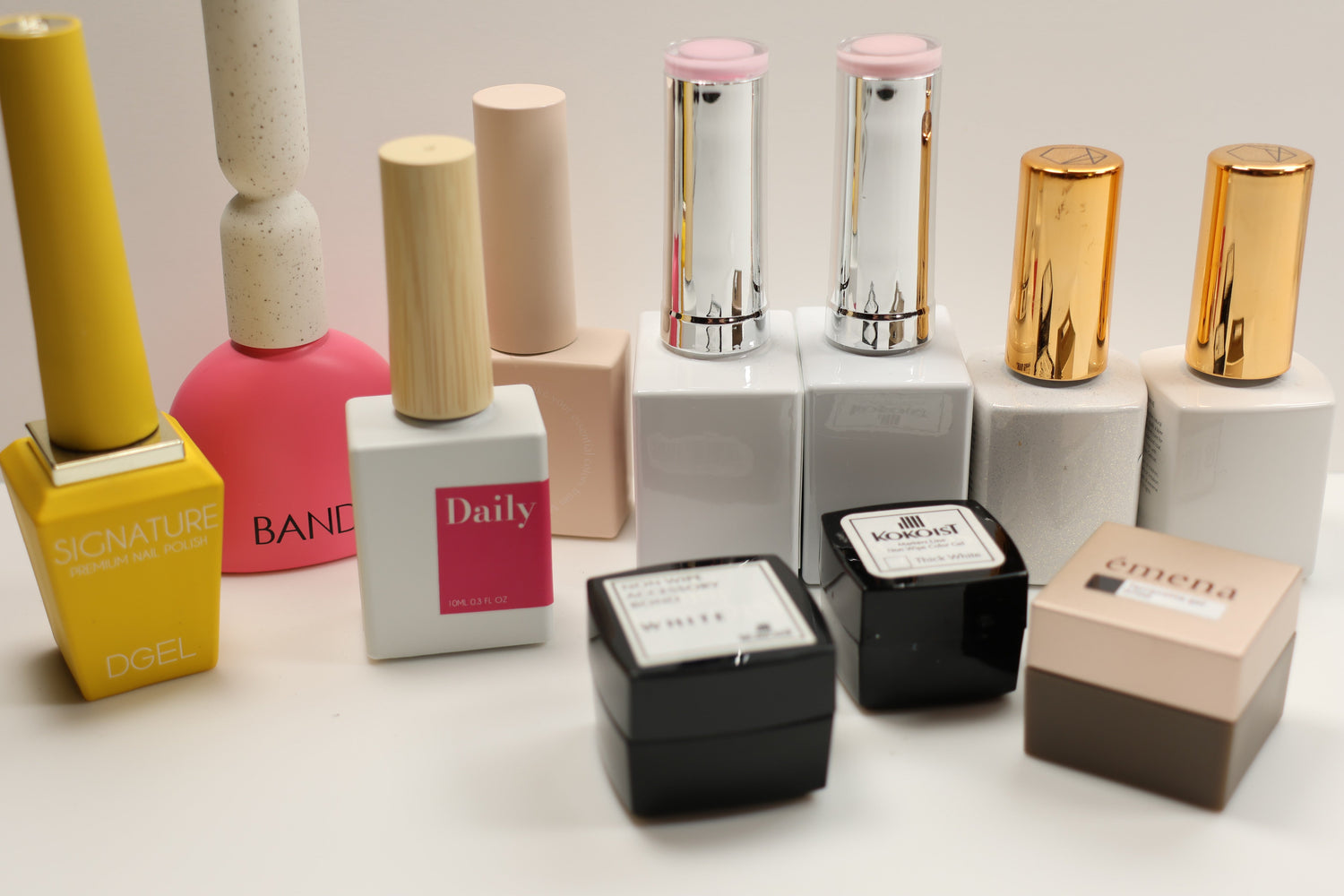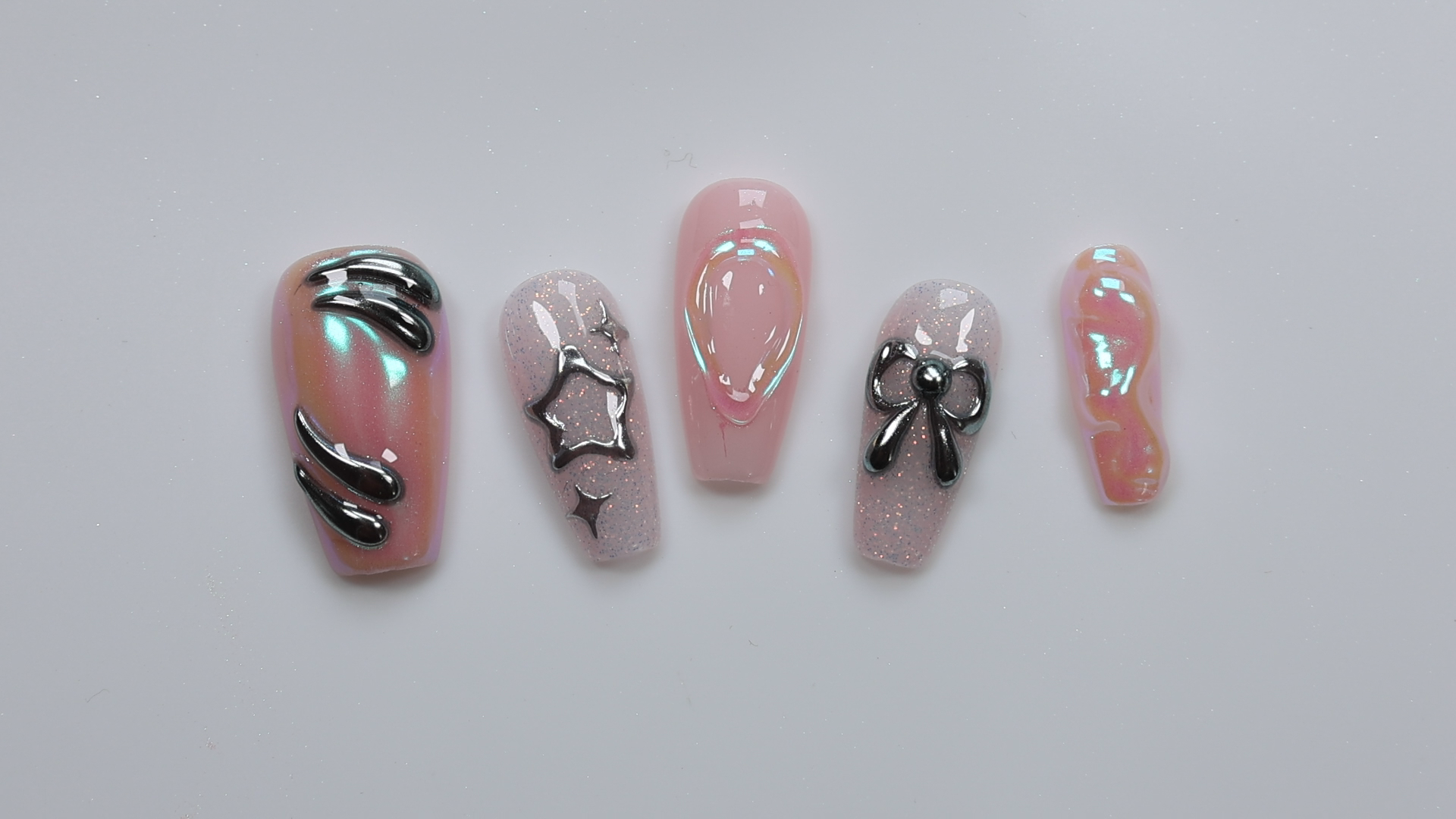
Have you ever wondered what the differences are between Western, Korean, and Japanese gels? Never before has there been such a wide and accessible selection of gel nail products available worldwide. While lacquer and acrylic have long dominated the nail industry, gel is now at its peak. Gel was first developed in the 1980s and popularized in the 2010s. Today, innovative gel formulas continue to emerge, making gel manicures, enhancements, and nail art easier and more accessible for both professionals and DIYers.
Korean and Japanese gels became more widely available in North America after COVID, gaining immense popularity among professionals and hobbyists and setting nail art trends. Their unique qualities have inspired a passionate niche community that uses and praises Korean and Japanese gels. With the rise in popularity of Korean and Japanese gels, it’s only natural to ask: How do Western, Korean, and Japanese gels differ? Is one type better than the other? Let’s uncover the general features of each and explore what makes them unique. Understanding the distinctions between Western, Korean, and Japanese gels can help you identify which type best aligns with your nail style and nail needs.
Korean Gels

Korean gels are desired for their aesthetically pleasing packaging, high-performing qualities for beautiful manicures, and usability for trendy and artistic nail art. Many Korean gel brands offer full color collections, though often limited to essential colors or frequently used shades based on salon research. Regardless of the slimmer options compared to typical Western gel collections, many Korean solid color gel polishes are highly pigmented and deliver full opacity, making them usable for painting nail art without double layering. The formulas self-level easily, resulting in smooth and even application.
One of the most admired qualities of Korean gel is the packaging. From unboxing a new purchase of Korean gels to displaying them on the shelf, Korean gels deliver aesthetics to the fullest. There are brands to suit all styles from clean and minimal to pretty and cute. From simple to luxurious premium designs, Korean gel brands place a strong emphasis on presentation that complements the product’s quality. Korean gel bottles of conscious brands are designed with both style and purpose, as many Korean gel brand bottles display the gel color in a way that makes it easy to identify at a glance. Functionality is equally important as bottle and brush handles are ergonomically shaped for ease of use. This balance of beauty and practicality enhances the user experience and showcases the meticulous craftsmanship that Korean gels are celebrated for.
Compared to Western gels, Korean brands release new seasonal or theme-based gel collections and upgraded gel products more frequently. These collections feature in-trend colors. While each collection may include fewer shades compared to full collections, the continuous release allows artists to expand their gel collection with fresh and fashionable colors throughout the year.
Korean gel comes in a wide variety of fun and playful types, including magnetic satin gels, magnetic gels with iridescence, reflective glitter gels, and more. Syrup gels or translucent gels, which have become a hallmark of Korean gels and manicures, offer a muted or neutral color with a glossy effect and popularized the trend of Korean jelly nails. Some brands even specialize in specific gel types. For example, Aurora Queen focuses on glitter gels while By Muse is known for syrup and tint gels. Although there are a plethora of Korean gel brands that specialize in specific gel types or concepts, some are actually developed by the same company. For example, DGEL, By Muse, and Aurora Queen are brands by the same company. This specialization of brands allows a focus on creating a rich variety within their niche categories.
Unlike many Western gels made primarily for professional salon use, Korean gels cater to a broader audience–professionals and DIY users alike, making them widely accessible.
While simple, neutral nail looks never go out of style, Korean gels are often nail-art oriented, offering a wide variety of gels that inspire creativity and expression. Korean nail products are primarily designed for gel manicures and nail art. Although some Korean brands offer gels suitable for enhancements, extension and structured nail systems are less common compared to Western options. Western gel systems are more comprehensive to support gel extension services. As Korean trends continue to evolve and brands expand toward a global market, we may see an increase in offerings tailored for structured and long nails.
Japanese Gels

Japanese gels are celebrated for their premium quality, versatility, and high color payoff. While some Japanese gels come in bottles, many are traditionally packaged in jars, allowing artists the flexibility to choose their own brushes, control product amount, and achieve precision in application and detailed nail art.
Rather than trendy colors, Japanese gel collections emphasize timeless colors suitable year-round, ranging from bright tones to deep classic shades. From highly pigmented opaque gels to sheer gels, Japanese gels can be layered or blended, making them great for nuance nail art, a popular Japanese nail art style that emphasizes evoking a mood or feeling through nail art.
Compared to other gels on the market, Japanese gels are usually slightly more viscous. They also self-level smoothly and result in longer wear. Uniquely, Japanese gels typically do not require a separate bonder or primer, as adhesion is built into the base gel. This simplifies application and eliminates the need for abrasive steps to the natural nails during preparation.
For creative nail artists, Japanese gels offer an impressive array of specialized gel textures and types for various effects. For example, Japanese nail brand émena offers 3D clay gel, bubbles gel, terracotta gel, wavy gel, whip gel, and various types of magnetic gels with beautiful sparkling effects.
While Japanese gels are designed for professional use, they are accessible to DIY users as well. Regardless of professional or hobbyist status, Japanese gels are for artists who appreciate specialty nail products. Japan has strict regulations, adherence to high-quality ingredients, and small-batch production that allows for meticulous oversight when it comes to the production of gels. They are formulated to be free of harmful chemicals (when products are used as intended) and gentle on nails with durable, chip-resistant for long wearing manicures. These high standards for quality are the reason why Palette Carys and perukā gel products are made in Japan. Japanese gels convey that nail work is more than a technical process–it’s an art form rooted in craftsmanship.
Western Gels

If you’ve gotten a gel manicure at a typical North American salon, you’ve likely experienced Western gel. Usually packaged in bottles with a minimal and professional design, Western gel brands offer extensive color ranges, including subtle pastels to bold neon shades. These gels are typically designed for salon efficiency, catering to single-color manicures that meet mainstream demand.
Established Western gel brands produce gels as part of a complete system that includes lamps, base coats, top coats, and enhancement gels. With these systems, there are typically also education options for mastering brand product application. Whereas Korean and Japanese gels cater more to nail art and creative expression, Western gels cater more to nail foundation through nail services.
Western gel polish options traditionally have thin watery formulas, requiring two or more coats so they can be applied efficiently and fully cure between layers. Some gels may also have moderate to strong odors, though newer formulations have improved significantly.
In the current landscape, some Western gel options have upgraded gel formulations that reduce odor, eliminate specific ingredients to minimize skin irritation (such as HEMA-free and TPO-free), offer better color payoff, and provide smoother application, compared to in the past. Overall, Western gel polishes remain a staple for professional use in salon settings with high traffic that require efficiency in services and come in a wide range of colors to suit a diverse clientele.
For gel enhancements, Western brands excel with builder gels, hard gels, and polygels that are formulated to add structure, strength, and length to the natural nail. In the European Union, cosmetic ingredients–including those used in gel products–are subject to stricter safety regulations to protect consumer health. As a result, certain ingredients such as TPO (trimethylbenzoyl diphenylphosphine oxide) are restricted or banned under EU cosmetic standards.
A Western gel brand that focuses on enhancements is MGart, which offers gels made for building thin, strong, and long-lasting nails with structured support. Its gel formulas are developed, mixed, and batch-tested in the EU, making them HEMA-free, TPO-free, 10-free, and fully compliant with EU cosmetic standards.
Although Western gels may be limiting in gel types for creative expression, have less frequent gel collection releases, and have more of a technical purpose towards nails than an artistic one, they make a solid and reliable choice for nail settings that require an efficient and professional system.
Summarized Points:
Korean Gels
-
Bottled packaging
-
Subtle or soft color color palettes
-
Highly pigmented opaque gel colors
-
Playful and trendy color types
-
Gels for nail art
-
Mostly soak-off formulas
-
Professional quality yet beginner friendly and DIY accessible
Japanese Gels
-
Traditionally potted (some bottled)
-
Deep colors
-
Wide variety of artistic gels with different textures and effects
-
Gels for nail art
-
Mostly soak-off formulas
-
Professional-grade with DIY accessibility
Western Gels
-
Bottled packaging
-
Extensive color range
-
Limited in gel types and textures
-
Gel systems
-
Structure and length building gels
-
Professional use
If you are seeking a comprehensive collection of colors with a reliable gel system for building structure and length, Western gels offer solid options. If you prefer trendy and artsy nail looks with curated color collections, Korean gels offer the best to choose from. For specialized nail artists who desire unique creative expression, Japanese gels offer quality and a wide variety of gels types for artistic freedom and creativity. In summary, one type is not necessarily better or worse than another. The type that fits your nail needs and nail style are the best type of gels for you. With a plethora of gel options, the nail possibilities are limitless.
Please keep in mind that every gel brand is unique in its formulation, purpose, and quality–regardless of origin. A brand’s country of origin or manufacture does not solely determine its performance, features, or overall quality. Each brand develops its products based on its own goals, target market, and creative direction, which may not always reflect or align with the general observations mentioned in this article. The information provided is intended as an overview and general guide rather than a definitive standard, as new brands and innovations continually emerge, reshaping the gel industry.




Leave a comment
This site is protected by hCaptcha and the hCaptcha Privacy Policy and Terms of Service apply.